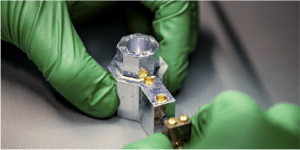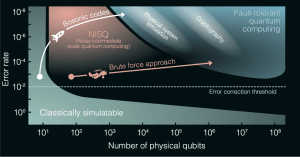
By Nord Quantique posted 30 May 2024
There exists a widely-held consensus in the quantum computing industry that the full industrial potential of quantum computers cannot be delivered until those building the machines reach what is known as “fault-tolerance”. This will be the point where errors in these machines are suppressed at a level sufficient to enable the complex computations required by industrial users. The challenge that most approaches to quantum computing face is that they require a large number of qubits to be kept in overhead, dedicated to error correction. At Nord Quantique avoiding this pitfall is our obsession!
In 2020, our company was founded on the idea that efficient error correction for quantum computers was not only a key element to the advancement of this technology, but the central challenge on the road to fault-tolerance.
At Nord Quantique, this meant that rather than developing machines with a large overhead of qubits as a redundancy for error correction, we would instead find ways to make individual qubits more resistant to errors. This philosophy led to our demonstration of a 24% increase in individual qubit lifetimes, without any qubit overhead, recently published in a research journal.
We’ve achieved this using a combination of innovative hardware design, along with special software we’ve developed to correct errors autonomously, as they arise.

Consequently, our qubits are quite different from most others and operate with intrinsic redundancy built-in. A superconducting cavity is used to store multiple long-lived photons. Together they form a bosonic code which possesses the inherent redundancy required for error-correction. Using an auxiliary superconducting chip, along with other microwave drives, provides full control over the code. This enables error-correction to be performed alongside other operations, and the gates required for quantum computing.
The combined approach allows us to address the two most common types of errors in quantum computing, bit flips and phase flips, without a large overhead of qubits devoted to error correction. This gives us the means to reduce errors using tools beyond pure chip improvement, and opens up a path towards reducing the number of qubits required to achieve fault-tolerance from many millions, to just hundreds. Nord Quantique’s platform also offers additional advantages including:
- Smaller systems with only hundreds of qubits instead of millions are much simpler to design, build and control. They also cost less to engineer. This means Nord Quantique has a shorter path to achieving fault-tolerance.
- Built with superconducting circuits, these machines will have fast processing times, with speeds in the megahertz range. This allows advanced calculations using deep circuits and complex algorithms to be performed in a timely manner, in accordance with the needs of industrial users.
- Our smaller systems will also deliver dramatically reduced size and energy consumption, making them less costly to operate.

We believe this solution is the fastest way to achieve useful quantum computing, and offers a range of advantages beyond just those listed above. Because of these unique advantages, we have been able to engage with corporate partners across a variety of industries, each with their own unique computing requirements and challenges. We therefore encourage any interested stakeholders to connect with us in June at IQT Pacific Rim or IQT Nordics to learn more about how Nord Quantique will deliver valuable quantum computing solutions in the near term.
- SEO Powered Content & PR Distribution. Get Amplified Today.
- PlatoData.Network Vertical Generative Ai. Empower Yourself. Access Here.
- PlatoAiStream. Web3 Intelligence. Knowledge Amplified. Access Here.
- PlatoESG. Carbon, CleanTech, Energy, Environment, Solar, Waste Management. Access Here.
- PlatoHealth. Biotech and Clinical Trials Intelligence. Access Here.
- Source: https://www.insidequantumtechnology.com/news-archive/an-obsession-with-error-correction-drives-nord-quantique-to-design-efficient-quantum-computers-without-large-overhead-of-qubits/



